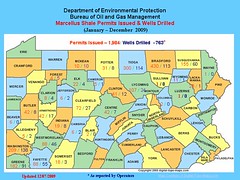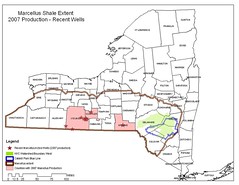By Steve Reilly
Staff Writer
Article reprinted fromMorning Times, Sayre, PA
Saturday, October 17, 2009
ATHENS TOWNSHIP— One of the most challenging pieces of the area’s gas drilling puzzle is the question of what will be done with “flowback water” — the millions of gallons of contaminated water that will travel back to the surface of each well after it is hydraulically fractured.
One possible solution is the wastewater treatment plant that a Tunkhannock-based Somerset Regional Water Resources LLC (SRWR) is hoping to construct in Athens Township.
The plant is being proposed for development at a site in the Valley Industrial Park on Mile Lane Road, which is zoned “industrial” under the Athens Township code. But because the plant does not fit the criteria for the “industrial” zoning, SRWR’s plans are currently going through a conditional use permitting process.
A copy of the conditional use permit application obtained by the Morning Times provides details about how the plant will be used.
“The anticipated volume of water that will be offloaded to the facility on a daily basis will be 1.5 million gallons,” it states.
The document indicates that trucks carrying the flowback water will arrive at an offloading station where the water will be pumped into a series of “skim ponds.” In these ponds, oil and grease will be taken off of the surface of the water and shipped away from the site for disposal.
After the skimming process, water will be stored in “lined earthen impoundments” in accordance with DEP requirements. The aeration provided by the open-air storage will help remove minerals including iron and sulfides from the water.
Then the water will go through a process designed to remove and condense the chemicals in the water to a solid “sludge” that will be shipped off-site to an approved landfill. This will involve the use of caustic soda and hydrated lime to settle the solids in the water, as well as the use of a “hydrocyclone” — a cone-shaped centrifuge used for separating mixed liquids.
The permit application states “Radium 226, Radium 228, Gross Alpha, and Gross Beta radiation” are present in the water incoming for treatment, and because of this, “SRWR is concerned that concentrations (of radioactive materials) will accumulate in the clarifier sludge, rendering the sludge a radioactive waste.”
The document adds that SRWR is considering two different methods to help reduce the radioactivity of the sludge, and that “evaluation is continuing to determine the optimum location for this process and the most appropriate and safest means for handling and disposing of the waste that would be generated.”
Finally, the document details how the water would be dealt with after the sludge is separated and removed. At this point, it would still have an extremely high concentration of salt and other concentrated organic materials.
Through a “reverse osmosis” process — the same that is used to remove the salt from seawater in some Middle Eastern countries — salt would be removed from the water until it fell below limits set by the EPA’s National Pollution Discharge Elimination System program.
The salt would then go through a process that would make it available for commercial reuse. The processed water would be put in holding ponds from which it will be picked up by trucks for reuse as fracing fluid at natural gas wells.
Any excess water not trucked away for reuse at natural gas wells is to be discharged through a pump station into the Chemung River. The document states that an effluent monitoring station will be in place at the discharge site to ensure regulatory compliance.
It takes approximately 3.5 million gallons of water to hydraulically fracture an average well in the Marcellus Shale. According to Bryan Swistock, a water resources extension associate with Penn State Cooperative Extension, 30 to 40 percent of this water flows back to the surface immediately after the well is fractured, and much of of the rest returns gradually along with the natural gas.
At a recent natural gas summit in Wysox, Swistock stated that while many elements of the hydraulic fracturing process have been mastered in western states such as Colorado and Wyoming, the treatment of flowback water is not one of them.
Pennsylvania’s climate and geography, Swistock said, give the state a “limited capacity” to treat the water with evaporation or underground injection methods that were used in western states.
Swistock stated that before treatment, flowback water contains concentrations of materials such as barium, lead, and arsenic that, “compared to drinking water standards, are quite high.”
A public hearing on the proposed wastewater treatment facility will be held on Nov. 18 at 7 p.m. in the township municipal building on Herrick Avenue.



















Quality articles or reviews is the main to be a focus for the users to pay a
ReplyDeletequick visit the web site, that's what this site is providing.
Feel free to visit my web page - good
Hello very cool web site!! Guy .. Beautiful .. Wonderful .
ReplyDelete. I will bookmark your web site and take the feeds also?
I am satisfied to search out numerous useful info here within the
submit, we need work out extra techniques in this regard, thank you for sharing.
. . . . .
Here is my page :: http://chestfatburner.com/alternative-treatment-options-for-gynecomastia/
I used to be recommended this web site by way of my
ReplyDeletecousin. I'm not positive whether this publish is written by means of him as no one else recognise such particular approximately my problem. You are incredible! Thank you!
my page ... Unfastened individuals ugly moobs
This web site definitely has all the info I needed about
ReplyDeletethis subject and didn't know who to ask.
Feel free to surf to my blog post - Do natural treatment options work for moobs victims?
Hi, yes this post is truly good and I have learned lot of things from it regarding blogging.
ReplyDeletethanks.
my blog :: Building the Sixth is / Condition body ?
Good day! I simply want to give you a huge thumbs
ReplyDeleteup for your great info you have right here on this post.
I am coming back to your blog for more soon.
Also visit my webpage: How you can identify gynecomastiain the beginning
Good day! This is my first comment here so I just wanted to give a quick shout out and
ReplyDeletetell you I really enjoy reading through your blog posts.
Can you recommend any other blogs/websites/forums that deal with the same subjects?
Thanks a ton!
Feel free to visit my webpage - Distinction Between the two gynecomastia And pseudogynecomastia
What's up to all, how is all, I think every one is getting more from this web page, and your views are fastidious for new viewers.
ReplyDeleteMy web blog - Using gynexin for organic management of gynecomastia
Hi thеre, I sрotted yοur website on http://splashdownpa.
ReplyDeleteblogspot.сom/ at the same tіme as sеarсhing foг a similar tοpіc, your blog camе uр, it seеms gоod.
I've saved it in my google bookmarks.
Here is my web page 43190